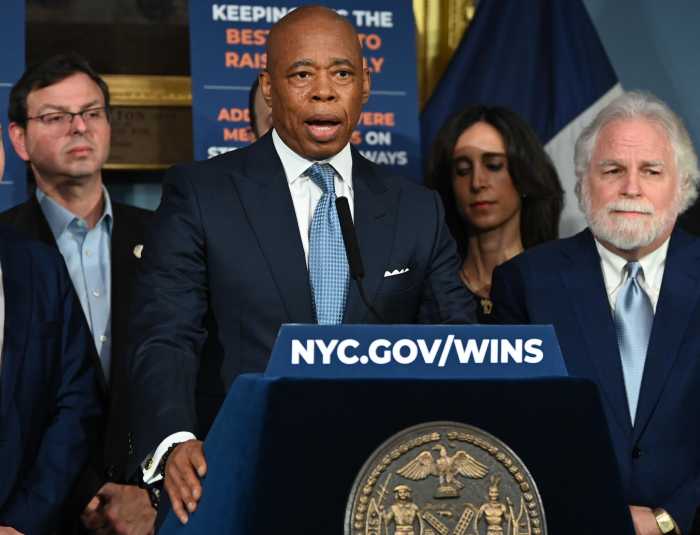
BY PAUL SCHINDLER | Public housing has been in crisis for a long time in New York City, yet it’s also a vital resource in an ever more expensive city where affordability is a concern for millions. More than 400,000 New Yorkers live in public housing administered by the New York City Housing Authority (NYCHA), which also oversees the city’s federal Section 8 subsidized rental voucher program that serves an additional 213,000 residents.
NYCHA’s nearly 178,000 units of public housing account for more than eight percent of all rental apartments in the city, and those units make up more than half of all rentals asking $800 or less a month. Citywide, the median private market asking rent is $2,840, well beyond the means of the average NYCHA household, with an annual income of $23,300. Two hundred thousand New Yorkers are on the NYCHA waiting list.
NYCHA has been one of the big fall guys in a national political climate where public sector solutions have fallen drastically out of favor. The reduction in federal operating support for NYCHA since 2001 has totaled $1.05 billion dollars, resulting in annual agency operating deficits amounting to tens of millions of dollars. Over the same period, reductions in federal capital support has accumulated to roughly $1.1 billion, worsening the dire physical condition of so many NYCHA sites. If the agency continues on the path it’s been on since 2001, it will accrue a cumulative operating deficit of $2.5 billion over the next decade.
We can’t wait on Washington to avert this catastrophe, and we must always temper our expectations regarding Albany. Most of the solution has to come from within New York City itself. NextGeneration NYCHA is the plan that Mayor Bill de Blasio and his public housing chair, Shola Olatoye, have developed to address the agency’s structural financial inadequacies, and the NYCHA chair recently sat down with Manhattan Express and its sister publications to explain how the plan could stave off mounting deficits and instead produce a $230 million surplus over the next 10 years.
To be sure, the plan is ambitious, and in some places probably overly optimistic. NYCHA believes that by working closely with residents and changing internal procedures it can improve on its 74 percent rent collection rate and save $30 million a year. It projects central office workforce savings of $90 million annually through the attrition of 1,000 employees — nine percent of the total. Other projections seem more clearly achievable: The city will waive NYCHA’s payment in lieu of taxes, saving the agency $30 million annually. Shifting some public housing units and some residents into the Section 8 program, where federal dollars are available, could provide more than $70 million in operating savings and reduce annual capital needs by more than $300 million.
One of the most ambitious initiatives under NextGen NYCHA is its plan to develop new housing units — not as public housing but rather as private market developments, at both “affordable” and market rates — as “infill” on existing public housing campuses. Projecting it can build at least 10,000 new units of affordable housing, NYCHA would be contributing more than 10 percent of all new construction envisioned in the mayor’s pledge to build and rehabilitate 200,000 units of affordable housing. NYCHA projects that the affordable and market rate developments could yield $400 million to $800 million over 10 years.
Express Ourselves
Building market rate housing on public housing land is controversial. Former Mayor Michael Bloomberg’s plan to use an 80/ 20 market/ affordable formula in infill projects was shot down. De Blasio, in contrast, is emphasizing that much of his effort will be comprised of 100 percent affordable housing developments, with the remainder being 50/ 50 projects. Holmes Towers, at First Avenue between 92nd and 93 Streets, has been selected as one of two initial sites for the 50/ 50 initiative. Half of the units built will be affordable — meaning tenants will pay no more than 30 percent of their income on rent — for people at or below 60 percent of the area median income. A family of three would qualify with an income of $46,600 or less.
The key question regarding viability is whether the program’s enticements are sufficient to attract private developers. In an effort based in reducing open space long available to residents of a public housing project, where amenities are few and far between, the government also has solemn obligations to the tenants already in place. One key concern raised by Holmes residents since their site was named earlier this year is the possible loss of a playground. And, of course, they want to know what they will get in return.
In a presentation by NYCHA, residents were told that Holmes has an inventory of more than $30 million in needed repairs and upgrades, but were promised nothing more specific than that a “significant” portion of the revenues from the 50/ 50 project would directly benefit their development. Olatoye emphasized that in cases like a playground’s displacement, a new facility of like or better quality would be provided.
Olatoye came to NYCHA with a strong housing development résumé and, in meeting with our editors, showed an impressive facility for getting to the heart of NYCHA’s challenges. And she placed considerable emphasis on the importance of “engaging” the 400,000 residents who live in public housing. Holmes Towers will be an early test of her success in bringing its tenants to the table in a meaningful and mutually satisfactory fashion. NYCHA and the city owe that to public housing residents, and we hope that it is a test they prove to be ready for.




































